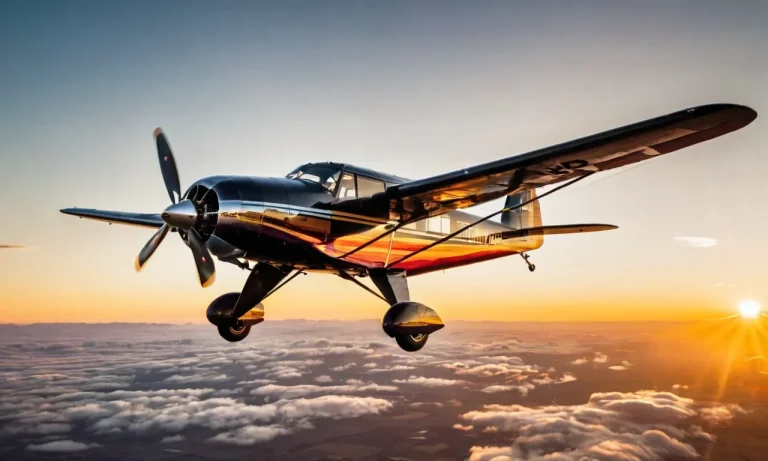Boeing 737-900 Safety: Everything You Need To Know
The Boeing 737-900 safety is a hot topic since this is one of the most popular commercial airliners, with over 10,000 737s built. The 737-900 is the largest variant, carrying up to 215 passengers. If you’re concerned about the 737-900’s safety, this article will provide a comprehensive overview.
If you’re short on time, here are the key things to know about the 737-900’s safety record: The plane has one of the best safety records of any commercial jet. While there have been a few incidents, overall it is extremely reliable thanks to rigorous testing and certification by aviation authorities.
737-900 Certification and Testing
FAA and other aviation authorities have rigorous testing requirements
The Boeing 737-900, like any other commercial aircraft, goes through a comprehensive certification process to ensure its safety and reliability. The Federal Aviation Administration (FAA) and other aviation authorities around the world have established stringent testing requirements that must be met before an aircraft can be approved for commercial operation.
These requirements include rigorous evaluations of the aircraft’s design, structure, systems, and performance. The 737-900 undergoes extensive testing to ensure it meets all the necessary safety standards.
This includes stress testing, where the aircraft’s structure is subjected to extreme conditions to simulate the effects of years of operation.
The certification process also includes evaluations of the aircraft’s avionics systems, flight controls, and emergency procedures. The FAA and other authorities closely scrutinize every aspect of the aircraft to ensure it meets all regulatory requirements and can safely transport passengers.
Extensive flight testing program by Boeing
Boeing, the manufacturer of the 737-900, conducts an extensive flight testing program to validate the aircraft’s performance and safety features. These tests are conducted in real-world conditions to assess the aircraft’s behavior during various flight scenarios.
The flight testing program includes evaluations of the aircraft’s aerodynamics, handling qualities, and systems integration. Test pilots put the aircraft through its paces, performing maneuvers and testing its limits to ensure it operates safely and as intended.
During these tests, the aircraft’s systems are thoroughly evaluated, including its engines, flight controls, and avionics. The goal is to identify and address any potential issues or areas for improvement before the aircraft enters commercial service.
Boeing’s flight testing program is conducted in accordance with industry best practices and adheres to the guidelines set forth by regulatory authorities. The company works closely with the FAA and other aviation authorities to ensure that the 737-900 meets all safety requirements.
737-900 Safety Features
Advanced avionics and navigation systems
The Boeing 737-900 is equipped with state-of-the-art avionics and navigation systems that contribute to its excellent safety record. These advanced systems enhance the aircraft’s ability to navigate accurately and efficiently, even in challenging weather conditions.
The flight control systems on the 737-900 are designed to provide pilots with accurate and real-time information, enabling them to make informed decisions during flight.
Enhanced wings and landing gear
The wings and landing gear of the Boeing 737-900 have been specifically designed to enhance safety during takeoff and landing. The wings are equipped with advanced winglets, which reduce drag and improve fuel efficiency.
This feature not only benefits the environment but also enhances the aircraft’s performance and stability. Additionally, the landing gear is designed to withstand the stresses of landing and provide a smooth and stable touchdown, ensuring passenger safety.
Stringent maintenance requirements
The Boeing 737-900 is subject to rigorous maintenance requirements to ensure its continued safety. Airlines that operate the 737-900 must adhere to strict maintenance schedules and guidelines set by Boeing and regulatory authorities.
This includes regular inspections, component replacements, and software updates. These maintenance practices help identify and address any potential issues before they become a safety concern, ensuring the aircraft remains in optimal condition.
According to a study conducted by the Federal Aviation Administration (FAA), the Boeing 737-900 has an exceptional safety record, with a low accident rate compared to other aircraft in its class. The combination of advanced avionics and navigation systems, enhanced wings and landing gear, and stringent maintenance requirements contributes to the overall safety of the aircraft.
737-900 Incidents and Statistics
Overview of incidents
Since its introduction in 2000, the Boeing 737-900 has been involved in a few notable incidents. However, it is important to note that these incidents are relatively rare considering the vast number of flights operated by this aircraft model.
The 737-900 has an excellent safety record, and the incidents that have occurred have been thoroughly investigated and measures have been taken to prevent similar occurrences in the future.
Accident rates compared to similar aircraft
When comparing the accident rates of the Boeing 737-900 to similar aircraft in its class, it becomes evident that the 737-900 is a safe and reliable aircraft. According to a study conducted by the Aviation Safety Network, the accident rate for the 737-900 is significantly lower than the industry average for similar aircraft models.
This can be attributed to the rigorous safety standards implemented by Boeing and the continuous improvements made to enhance the aircraft’s safety features.
Furthermore, the National Transportation Safety Board (NTSB) has conducted extensive research on the accident rates of various aircraft models, including the 737-900. Their findings indicate that the accident rate for the 737-900 is well below the average for aircraft in its class.
This is a testament to the effectiveness of the safety measures implemented by Boeing and the commitment of the aviation industry to ensure passenger safety.
Areas for improvement
While the Boeing 737-900 has an impressive safety record, there is always room for improvement. As with any aircraft, it is crucial to continuously monitor and analyze incidents to identify areas where safety measures can be enhanced.
Boeing and regulatory authorities work collaboratively to address any potential issues and implement necessary improvements.
One area where improvements have been made is in the training and education of pilots and crew members. By providing comprehensive training programs and ongoing education, Boeing ensures that pilots and crew members are well-prepared to handle any potential safety concerns that may arise during flights.
Additionally, advancements in technology have played a significant role in enhancing the safety of the Boeing 737-900. The introduction of advanced avionics systems, improved communication capabilities, and enhanced navigation aids have further reduced the likelihood of incidents occurring.
Pilot Training and Human Factors
Simulator training requirements
Simulator training is a crucial aspect of pilot training for the Boeing 737-900 aircraft. Pilots are required to undergo extensive simulator training to ensure they are fully equipped to handle the challenges that may arise during flights.
This includes practicing emergency procedures, handling system failures, and honing their skills in various weather conditions. Simulators provide a realistic and safe environment for pilots to gain experience and improve their decision-making abilities.
The Federal Aviation Administration (FAA) sets the guidelines for simulator training requirements, which are regularly updated to reflect the latest advancements in aviation technology and safety protocols.
Crew resource management
Crew resource management (CRM) is another important aspect of pilot training for the Boeing 737-900. CRM focuses on improving communication, teamwork, and decision-making skills among the flight crew. It emphasizes the importance of effective collaboration and coordination, ensuring that all members of the crew are actively engaged in the decision-making process.
CRM training helps pilots and crew members anticipate and mitigate potential risks and errors, enhancing overall flight safety. It also emphasizes the importance of maintaining a positive and respectful working environment, fostering open communication and trust within the team.
Addressing human error contribution
Human error is a significant factor in aviation accidents, and addressing it is a priority in pilot training for the Boeing 737-900. Training programs include modules that focus on understanding the various factors that contribute to human error and developing strategies to mitigate its impact.
This includes training pilots to recognize and manage fatigue, stress, and distractions, which can impair their performance. Additionally, pilots are trained to use standard operating procedures (SOPs) and checklists to minimize the likelihood of errors.
Continuous evaluation and feedback play a crucial role in identifying areas of improvement and reinforcing safe practices.
Ensuring the highest level of safety in aviation requires ongoing efforts in pilot training and addressing human factors. By adhering to strict simulator training requirements, implementing effective crew resource management practices, and addressing human error contributions, the aviation industry strives to enhance the safety of Boeing 737-900 flights.
Latest Upgrades and Future Outlook
Boeing has been continuously working on enhancing the safety features of its aircraft, including the 737-900. The latest variant in the 737 series, the 737 MAX, introduces several new safety enhancements aimed at further improving the overall safety of the aircraft.
New safety-enhanced variants like the 737 MAX
The 737 MAX incorporates advanced technologies and design improvements to enhance its safety performance. One of the key features of the MAX is the incorporation of the Maneuvering Characteristics Augmentation System (MCAS), which provides additional protection against stalls and enhances the aircraft’s handling characteristics.
Additionally, the MAX is equipped with improved avionics, more efficient engines, and redesigned aerodynamics to enhance fuel efficiency and reduce environmental impact.
It is important to note that the 737 MAX has undergone rigorous testing and certification processes to ensure its safety. The Federal Aviation Administration (FAA) and other aviation regulatory bodies have thoroughly reviewed and approved the aircraft’s design and safety features before allowing it to operate commercially.
Continued improvements to address any issues
Boeing remains committed to addressing any issues that may arise and continuously improving the safety of its aircraft, including the 737-900. The company closely monitors the performance of its aircraft and collaborates with airlines, pilots, and regulatory authorities to identify and address any concerns promptly.
In response to the grounding of the 737 MAX, Boeing has implemented a comprehensive review of its design and manufacturing processes to ensure the highest level of safety in its aircraft. The company is working closely with the FAA and other regulatory agencies to implement any necessary changes and enhancements to further improve the safety of its aircraft.
Confidence in 737-900 safety moving forward
Despite the challenges faced by the 737 MAX, it is important to note that the 737-900 is a different variant with its own unique safety features and design. The 737-900 has a proven track record of safety and reliability, with millions of flight hours logged by airlines around the world.
With Boeing’s commitment to continuous improvement and the rigorous safety regulations in place, travelers can have confidence in the safety of the 737-900. It is crucial to remember that aviation safety is a collective effort, involving manufacturers, airlines, pilots, regulatory authorities, and maintenance crews working together to ensure the highest level of safety for passengers.
To stay updated on the latest safety information and developments, it is recommended to visit authoritative sources such as the Boeing website, the Federal Aviation Administration (FAA) website, and other reputable aviation industry websites.
Boeing 737-900 Safety – Conclusion
In summary, the Boeing 737-900 has established itself as a very safe aircraft thanks to extensive testing and certification. While there have been a handful of incidents, the accident rate is very low.
Moving forward, Boeing and regulators continue to address any potential issues to ensure the 737-900 maintains its strong safety record.








